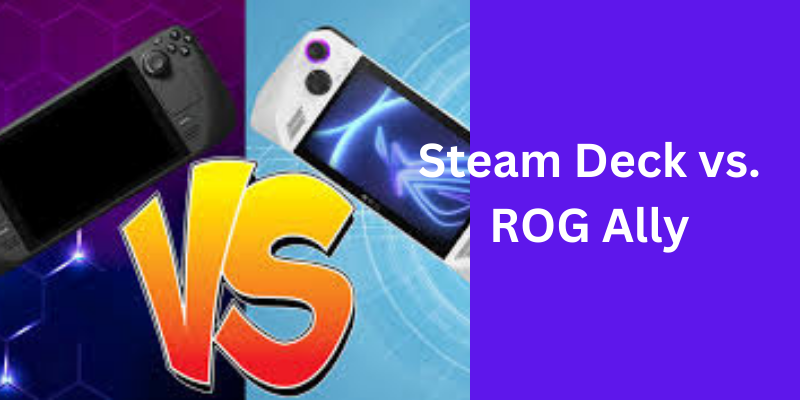Life became a lot easier for us once we were introduced to handheld gaming PCs. It provided us with the portability we wanted, along with the power of a high-end gaming PC, allowing us to take it anywhere and play it whenever we want, wherever we want.
It all started off with the good ol’ Steam Deck.
The pioneer of handheld gaming PCs was on the throne for quite a while, until other handheld gaming PCs, such as the ROG Ally, joined the bandwagon and tried to dethrone the Steam Deck.
The basic concept behind both of them is the same. You connect them to a fast, reliable internet connection, such as the one offered by Xfinity, and you can download and enjoy playing all your favorite games. If you’re planning to get a handheld gaming PC, I recommend that you take a look at Xfinity Internet plans so that you can get a connection at an affordable rate.
While both of them have the same features at the surface level, it’s the depth that sets them apart. So, the question is, which of the two is the better handheld gaming PC? Let’s find out.
Steam Deck Vs ROG Ally: A General Overview
While both of them are great in their own ways, some key differences between them make them unique. For instance, the ROG Ally has slightly powerful hardware and runs on Windows 11. It gives you greater game compatibility and higher performance compared to the Steam Deck.
However, all of this comes at the cost of battery life, and it has a slightly complex user experience.
On the contrary, the Steam Deck has its own operating software called the SteamOS, which is dedicated to giving the user a console-like experience, something like the PlayStation Portable (PSP) or PS Vita.
That makes the Steam Deck a lot more user-friendly and gives it a better battery life as well. However, users may face some compatibility issues periodically, and games with anti-cheat software generally don’t work.
Now, to go into the details of both the handheld devices, here’s everything in depth that you need to know.
The ROG Ally
Here are some of the pros and cons of the ROG Ally.
Why It’s a Great Option
- More Power: The ROG Ally features a more powerful and robust AMD Ryzen Z1 or Z1 Extreme processor, which allows it to handle more demanding games, even if you run them at higher settings.
- Windows 11 OS: The device runs on Windows 11, which lets you access a large library of PC games, including those that aren’t available on the Steam Deck.
- Higher Refresh Rate: The ROG Ally’s screen takes the lead as it gives you a higher refresh rate, up to 120Hz. This gives you smoother visuals as you enjoy your favorite games.
- Superior Storage Options: The device has a slightly faster SSD in it, and it supports the UHS-II version of microSD cards, which allows you to have faster storage expansion. This allows you to store more games on your Ally and run them faster.
Factors to Consider
- Shorter Battery Life: Since the Ally has more powerful hardware, it takes a toll on the device’s battery. Faster battery drain means that you have to charge the Ally more often.
- Issues with Windows 11: Windows 11 tends to have bugs, and since the OS isn’t optimized for handheld devices, it can lead to potential issues in the device.
- Higher Price Tag: If you look at both devices in terms of prices, then the Ally costs you more than the Steam Deck.
- Issues with the SD Card Reader: Some users complained about the SD card reader in the earlier models, which would lead to SD Card damage in the device.
The Steam Deck
Now, let’s take a look at some of the pros and cons of the Steam Deck.
Why It’s a Great Option
- User-Friendly Interface: SteamOS was designed in such a way that it worked great for handheld gaming, giving users a console-like experience.
- Longer Battery Life: The device has lower power consumption and a more efficient OS, which results in less power consumption and longer battery life.
- Ergonomic Design: The Steam Deck is designed in such a way that you can play for long gaming sessions without tiring yourself.
- Lower Price Tag: It has a lower price, which makes it more affordable for gamers, as compared to the ROG Ally.
- Great Community Support: A substantial chunk of the gaming community supports the Steam Deck by giving workarounds and mods for games.
Factors to Consider
- Slightly Less Powerful: The Steam Deck has slightly weaker hardware, which means that the device may have to struggle when you play demanding games at higher settings.
- Limited Compatibility: A few games, including those that have anti-cheat software in them, might not be compatible with the Steam Deck, which results in you having limited options to play.
- A Lower Refresh Rate: As compared to the ROG Ally, the Steam Deck has a lower refresh rate. This means that games won’t be that visually smooth.
However, in the end, it comes down to your preferences. If you want a powerful device with smooth visuals, then the ROG Ally is for you. However, if you want a more console-like experience with better battery life and ease of use, then the Steam Deck is the right pick for you!

